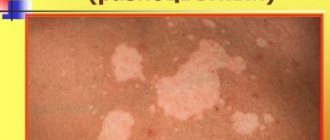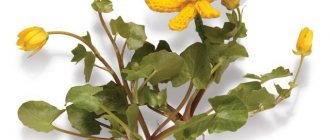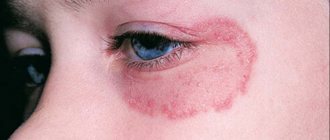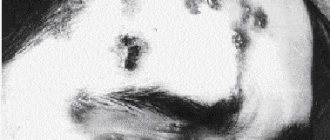Features of the course of the disease
A microscopic fungus that infects the top layer of skin and spreads spores into the mouths of the follicles. Activation of the disease does not occur immediately.
In the absence of favorable conditions, the fungus may not manifest itself in any way for a long time: from 15 days to several months.
At risk are school-age children and young people with reduced immunity, hereditary predisposition and a tendency to hyperhidrosis. Violation of personal hygiene rules, hormonal imbalances and gastrointestinal diseases can also push the onset of the disease to develop. Also, the development of lichen is promoted by foci of chronic infection in the body.
It can be:
- tonsillitis (chronic form);
- caries;
- tuberculosis, etc.
Symptoms of the disease are shown in the photo:
- Peeling of the skin surface.
- Increased sweating.
- The appearance of a specific rash.
- Possible itching.
The spots on the body have uneven edges and different colors. The further the disease develops, the larger the surface of the skin the rash covers. Most often, manifestations of the disease affect the armpits, chest, abdomen, back and sides.
For your information! Most cases of tinea versicolor affect the body, but can also occur on the scalp or nails.
The course of the disease is uneven, alternating between active and fading periods. Most often, the disease begins to develop rapidly in the warm season with high humidity. A cosmetic defect that accompanies a disease causes a person a lot of trouble, disrupting his quality of life and complicating social adaptation.
How to cure lichen in a child
18.01.2022
Almost every second child at an early age manages to catch such a contagious disease as lichen . Before parents begin to solve the question: how to cure lichen , you need to understand what this disease looks like and what types of it exist.
How to cure lichen in a child?
Most often in children, pityriasis , one of the mildest forms of the disease. It makes itself felt by the appearance of pinkish spots on the body, flaking from the middle. Pink lichen often goes away without any intervention, but in order to clarify the diagnosis and not confuse it with red or multi-colored lichen , you need to take the child to the hospital .
Shingles cannot be confused with other types; it is very severe, has a viral nature, can recur again and again and cause complications . Skin rashes with this disease are similar to herpes, filled with fluid and very painful. The child has a fever and general weakness. Treatment is carried out with the help of antiviral drugs, immunomodulators and external ointments or creams, always under the supervision of a doctor .
The appearance of ringworm , which forms bald spots on a child’s hair, is associated with a fungal infection of the skin. to a doctor immediately . is treated with oral antibacterial drugs (Griseofulvin) and external antifungal agents (Clotrimazole, Lamisil).
How to avoid deprivation?
- Dress your baby in natural cotton clothes. Synthetic clothing does not allow the skin to breathe and promotes sweating .
- If it so happens that lichen occurs on warm summer days, then in order to get rid of it faster, you will have to postpone walks in sunny weather, or at least cover the affected areas of the skin with clothes.
- Water procedures should now also be limited; the lichen come into contact with water, otherwise it will spread more rapidly.
- Pay twice as much attention to your baby’s personal hygiene; all his things should be washed and boiled more often, separately from other things, and be sure to iron them.
- Disinfect the apartment, remove soft toys, carpets and other household items that may harbor pathogenic spores.
The signs of different types of lichen are sometimes very similar, and even an experienced specialist cannot always visually reliably determine what type of lichen the disease is and how to cure lichen in a child. Therefore, folk remedies are unlikely to help achieve the desired result, but by taking simple preventive measures, you can prevent the spread of the disease.
Published in Dermatology, Pediatrics Premium Clinic
Diagnosis and treatment
To select high-quality and effective treatment, the patient must undergo diagnostics. Without an examination, it is difficult to make an accurate diagnosis due to the similarity of symptoms with other diseases.
Diagnostic measures
Diagnostic methods:
- visual examination by a dermatologist;
- biochemical analysis;
- performing the Balser test;
- use of Wood's lamp.
There are the following types of diagnostics:
- Biochemistry. A scraping is taken from the patient. The resulting sample may contain fungal spores when treated with appropriate chemicals.
- Wood's method. The flaky top layer is scraped off. Areas affected by the fungus are detected using a special lamp that produces fluorescent staining. This analysis is carried out in a darkened room.
- Balser's test. An alcohol solution of iodine is used for analysis. It treats the surface of the skin on the diseased area of the body. Upon contact with the fungus, the color produced by iodine becomes more intense.
Remember! After diagnosis, the doctor prescribes appropriate treatment for the patient. It is selected separately for each patient, taking into account the patient’s condition and the duration of the disease.
Varieties of pityriasis rosea
- Typical form. It is formed from the mother's plaque.
- Antitypical shape. There is no redness, but vesicles and blisters appear on the body. Itching appears and spreads to the face; this is not typical for a typical pathology. A rash is observed, small bubbles form, which merge into one whole, the size is 10 cm.
The flaky atypical form has several stages:
- itching on the skin, small rashes;
- the formation of papules that have a rough, fine-grained surface;
- Whole lesions are observed, they are noticeable among uninfected areas of the skin.
Methods of drug therapy
The main goal of treatment is to eliminate the causative agent of the disease. For this purpose, oral and local antifungal drugs are used. This treatment can be carried out at home.
For your information! If the disease is advanced, treatment will be lengthy.
In order to cope with versicolor, the patient is prescribed a set of measures, including the following medications:
- Selenium preparations, for example, Sulsena.
- Fluconazole or analogue drugs.
- Antimycotic agents.
- Imidazole (Ketaconazole, etc.).
- Ozone therapy.
- Use of products with salicylic acid.
- Enrichment of the diet with vitamins.
In addition to the use of medications, the patient must strictly follow the doctor’s instructions regarding personal hygiene and maintaining a clean home. The duration of treatment in untreated cases is about a week.
Complication of pityriasis rosea
Relapses do not occur very often, but in some cases there are complications. These include folliculitis, eczema, osteofolliculitis and others. Re-infection can occur as a result of wearing uncomfortable clothes, not following therapy, or in people who suffer from allergies.
Secondary disease is typical on skin that is subject to stretching: thighs, groin, forearms. Infection appears in the sweat glands or on the skin of the face. If you notice the appearance of lichen, immediately contact a specialist. Timely treatment will avoid negative consequences.
Treatment with traditional medicine
The use of traditional medicine methods is possible only after agreement with the attending physician, since otherwise the body may be harmed and recovery will be delayed.
Recipe No. 1. Onion juice
For cooking you will need onions (2 pieces). It should be crushed and the juice squeezed out well. It is recommended to wipe the areas damaged by the disease with the resulting liquid using tampons.
Recipe No. 2. Calendula
One part of calendula flowers must be mixed with five parts of alcohol and left in the dark for 7 days. After this, the tincture is filtered and used to treat the affected areas of the skin.
Differential diagnosis of pityriasis rosea with other diseases
The disease is differentiated from psoriasis, parapsoriasis, seborrheic eczema, syphilis, trichophytosis. The pathology differs from seborrheic eczema by the maternal plaque, the location of rashes that are not characteristic of eczema. Among other things, with seborrheic eczema the scales are often greasy.
Unlike psoriasis, lichen is spotty; it does not appear on the feet, hair, or hands. Difficult diagnosis is observed in the first stage of the disease.
There is a similarity between the disease and parapsoriasis; the spots may be similar. However, peeling and identical spots are not characteristic of lichen.
Lichen differs from syphilitic roseola in its brightness and the presence of peeling, since this is rarely found with syphilis.
Diet for lichen
Nutrition during treatment of lichen depends on the type of disease, but there are foods that are equally useful for skin lesions of any type of fungus:
- green vegetables, herbs;
- dairy products;
- breakfast cereals;
- mineral water;
- natural honey;
- foods high in iron.
Pityriasis rosea requires adherence to a dairy-vegetable diet.
For shingles, ringworm, lichen planus and multicolored lichen, it is necessary to enrich the diet:
- foods rich in vitamin E (peanuts, sea buckthorn, rose hips, eel, walnuts, viburnum, sorrel, squid, hazelnuts, prunes, salmon, oatmeal/barley, seeds, vegetable oils);
- products that are sources of antioxidants and bioflavonoids (apples, grapes, apricots, blueberries, cherries, prunes, blueberries, carrots, kiwi, cherries, sweet red peppers, barley, raisins, etc.).
The list of prohibited products for the treatment of any type of lichen includes:
- spices (mustard, pepper, horseradish);
- spicy dishes, pickles;
- alcohol;
- tangerines.
It is necessary to limit consumption:
- offal;
- smoked meats, mushroom and meat broths;
- fatty fish;
- canned food;
- salty and spicy cheeses;
- cream cakes;
- legumes;
- products with preservatives.
Drink coffee, strong black tea and cocoa in small quantities.
Why is lichen dangerous?
The harm that lichen can cause to health depends on its type. Pityriasis rosea always occurs without complications. The prognosis of the disease is favorable for ability to work and health.
Shingles is more dangerous. It can lead to:
- decreased motor activity in the limbs;
- partial loss of sensation in the limbs;
- inflammation of the membranes of the spinal cord/brain (encephalitis, meningitis);
- viral damage to the lungs and liver;
- the addition of a secondary infection;
- inflammation of the cornea, eyeball, loss of vision.
The most common consequence of shingles is postherpetic neuralgia. This disease develops after an illness and is manifested by severe pain. Only after a few months the pain goes away.
Pityriasis versicolor and ringworm can lead to a secondary infection. This makes the treatment process more complicated and requires the use of broad-spectrum antibiotics. Trichophytosis can also lead to the formation of bald patches that will last a lifetime.
Complications of lichen planus include:
- addition of bacterial infections;
- inflammation of the oral mucosa.
Folk recipes
There are many recipes for external use, suppressing pathogenic pathogens, and restoring the dermis. The main thing is to use suitable options at the initial stage of the disease, so that in case of complications you do not have to resort to more expensive, aggressive pharmaceutical drugs:
1 Garlic. Grind a couple of cloves into a paste, add linden honey. Apply to plaques for up to 3 weeks in a row.
250g lard, 50g pork brain, 3g salicylic acid. Melt the ingredients in a water bath and stir. Apply to the epidermis while warm, wrapping it with polyethylene on top. Leave for 3 hours, wash off with soapy water.
Pour 350g of walnut leaves into a glass of water. Simmer over low heat for 30 minutes. Pour the broth into the bath, soak your hands or feet until the itching disappears, 2 times a day.
4White mustard. Pour 30g of water and leave for 3-4 hours. Grind into pulp. Apply in the evening to the dermis, leaving until the morning. Course - 5-10 days.
5Iodine is an effective way to eliminate infection at an early stage. Treat the affected areas carefully, avoiding dryness and burns on the body.
6Birch tar. Mix with ashes in a ratio of three to one. Apply the resulting mixture and let it sit for 3 hours. Rinse off with warm water. Course - 1 week. Tar can be combined with fish oil mixtures - one to one, spreading the mixture in a gauze bandage and locally to the spots. For cutting, it is effective to use concentrated tar with the addition of salicylic acid. For pink lichen, a recipe with butter is suitable, providing moisturizing and antiseptic properties.
Solutions and tinctures for external use
There are many known folk remedies for lichen, so everyone who is sick can choose an acceptable option for themselves, which is no less effective than expensive pharmaceutical drugs.
Component
Recipe
Mode of application
Lilac
Flowers – rinse 100 g, combine with a glass of vodka. Leave in the dark for 10 days
Use as a tincture on affected areas of the body
Birch buds
Infuse in boiling water (1×1), simmer for 15 minutes, cool. Strain
Apply to sore spots
Pollen from a mature puffball mushroom
Mix with vodka, keep in the dark for 10 days
Treat outbreaks
Garlic
Grind 100 g of product, add a glass of castor oil. Simmer in the oven for 2.5 hours, strain
Lubricate affected areas twice a day
Propolis
Pour medical alcohol – 200 g into 50 g, leave for 7 days in a dark place
Treat lesions with cutting type
Calendula and castor oil
Mix 1x1
Carry out procedures 2-3 times a week
Celandine
20 g of herb, add 1 glass of water, soak in a water bath for 20 minutes, cool
Soak a cotton pad in the broth and wipe the affected areas
Celandine
Pour 300g of celandine into 100g. alcohol Stand in a dark place for 21 days
Wipe the affected areas twice a day
Peas
Pour 100 g of boiled water – 1 glass. Simmer over low heat for a quarter of an hour
Apply decoction to lichen spots
Aloe
Chop the leaves, add cold water and leave
Wipe flaky areas
Plantain and yarrow
Take 1x1 leaves, chop, squeeze out the juice. Memory. Wrap the mixture in cheesecloth
Apply to pink-whitish spots for 30 minutes, repeat three times a day
You can take 10-minute baths when treating ringworm with vinegar.
Wormwood has proven itself to be excellent in therapy. Its strong decoction can be used as a rub.
An old newspaper can also help with illness. It needs to be rolled up and tied with thread. Place the turret on a plate and set the top on fire.
The result is a dark brown liquid. She needs to lubricate the sore spots warm 2-3 times a day.
Compresses
Garlic is a natural antiseptic. Quickly suppresses fungus and returns the skin to its previous appearance if applied as a compress. Garlic can be combined with honey and lemon to neutralize the pathogen and restore the integrity of the dermis.
Garlic vinegar
Pour 3 cloves of garlic with 1 glass of apple cider vinegar. Leave in the dark for 14 days. Moisten the affected areas. In the morning, change the compress to a new one.
Garlic and honey
Combine 2-3 cloves with honey until smooth. You can add apple cider vinegar. Lubricate lichen plaques for up to 2-3 weeks in a row.
You can rub garlic in its pure form or combine it with lemon to make a paste.
Boric acid.
1 tsp add a couple of glasses of cold water. Keep on fire until dissolved. Soak cotton swabs and apply for up to 6 days in a row. On day 7, you should wash, change clothes, and then repeat the course of treatments.
Herbal mixture
Rose petals, blackberry leaves, calendula flowers, horsetail. Take equally 2 tbsp. l., pour 300 ml of boiling water, simmer over low heat. Moisten gauze and apply to sore spots when treating the pink type of disease.
Sagebrush
2 tbsp. l. herbs pour 200 ml of boiling water, leave under the lid. Moisten the gauze bandage and apply for 7 days.
Beetroot with honey
Grate the beets, add honey in a 1x1 ratio. Apply the compress to the affected areas, covering the top with film.
Sea buckthorn oil will help with the flat type of pathology. Moisten gauze bandages and apply to the body as a therapeutic compress.
The acid in lemon helps a lot. You can apply fresh fruit slices, leaving them on the skin for a few seconds, repeating the procedure every 3 hours.
Rashes and lichen spots disappear from ordinary table salt by moistening it with your own saliva.
Reference! The ancient method of control is unusual: collecting condensed moisture from window glass. It is enough to blow hot air on the window, collect drops of condensation and treat the rashes twice a day.
Homemade ointments and creams
Ointments and creams are widely used in the treatment of lichen in humans. They have a thick consistency, so they will not spread and are perfectly absorbed.
1Salt and soda. Stir, dilute with water. Rub in twice – morning and evening.
2 Celandine and rendered internal lard (1x1). Carry out processing. Store the healing ointment in the refrigerator.
3Hops, burdock and calendula. Prepare a decoction by pouring boiling water over it and simmering for a few minutes over low heat. Add pharmaceutical Vaseline. Use as an ointment.
4Burning brimstone. Grind to a fine powder, mix with boric ointment and lanolin (1x3). Apply ointment 2 times a day.
Birch buds
Melt 500 g of lard, add 1 cup of kidneys. Place in the oven for 3 hours in a clay dish. Cool, drain the fat into a glass pharmacy container.
Treat affected areas twice a day.
A decoction with wound-healing and antibacterial properties is prepared from birch buds and added to baths for eczema and dermatitis.
Propolis and vegetable oil
Mix 20 g with 100 g of oil or Vaseline, heat in a water bath, leave for 24 hours. Mix and rub into affected areas.
You can use an alcoholic propolis composition by mixing it with any fat base.
Celandine
It helps well with fungal pathology at an early stage, has anti-inflammatory and analgesic properties. Add petroleum jelly and 30g lanolin to 40g of crushed herb, mix and apply on lichen 2 times a day.
Also combine celandine juice with melted lard, spreading it on the hearths twice a day.
An interesting recipe is based on tar and ash after burning a birch log. Mix the components (3x1), apply to the affected areas of the dermis, leaving for up to 3 hours to get rid of psoriasis, a scaly type of pathology.
Which doctor should I go to if my child has shingles?
As we have already mentioned, a doctor who diagnoses and treats dermatological diseases is a dermatologist. Since the structure and functioning of the skin of a small child is significantly different from the skin of an adult, it is the pediatric dermatologist who should make the diagnosis.
Features of children's skin that determine high sensitivity to external irritants and pathogens are:
- skin thickness (in an adult it is three times thicker);
- loose epidermis;
- lack of elastic fibers;
- weak ability to form skin pigments (low protective function);
- low degree of thermoregulation, etc.
Diseases of the skin and its appendages (hair and nails) can be a consequence of various pathological processes in the child’s body (systemic or autoimmune diseases, etc.), so additional consultation with a pediatric neurologist, immunologist, infectious disease specialist or other specialists may often be necessary.
Pityriasis rosea during pregnancy
The appearance of pityriasis is frequent with hormonal changes in the patient’s body or with a reaction to any foods. The pathology can be dangerous for the health of mother and baby, but it causes discomfort, itching and spots appear. The cause of the disease is weak immunity.
During lactation, women are not prescribed hormonal or antiviral drugs. When itching occurs, the dermatologist prescribes antihistamines, taking into account the woman’s condition. Ointments containing zinc are prescribed as external agents.
In pregnant women in the early stages, lichen has a negative effect on the fetus, since the disease is infectious. The child will not be able to become infected, but there is a possibility of miscarriage or the birth may be premature. Patients who are up to 15 weeks pregnant are susceptible to infection.
If lichen appears, you should consult a doctor. He will prescribe antihistamines in case of swelling, antibiotics if the disease causes complications. He will also prescribe vitamins C, A, B. Sedatives will need to be taken if there is a risk to the fetus. Taking medications on your own is not recommended, as this may have a negative effect on the child.
Causes and types of disease
Ringworm, microsporia, trichophytosis is a disease transmitted to humans from animals. Very often children who play with stray cats and dogs become infected. The disease can also be caught from a sick person through hygiene items, personal belongings and through direct contact.
Factors that provoke the appearance of ringworm in a person include:
- Contact with a sick animal, often a cat or dog. Infection is possible, including through lost fur. In this case, the disease is designated by the term microsporia, as it is caused by a fungus of the genus Microsporum, and is characterized by a more severe course.
- Ringworm is contracted through direct interaction with a sick person, for example, through handshakes and hugs. A fungus of the genus Trichophyton can parasitize humans. In this case, the term trichophytosis is used to refer to the disease.
- Infection through household and hygiene items: shared towels, soap, washcloth, comb, as well as dishes, shoes or clothing used by a sick person. Transmission of the fungus can occur by touching a surface that has been touched by someone infected with ringworm.








